.

New Horizons Returns New Images of Pluto
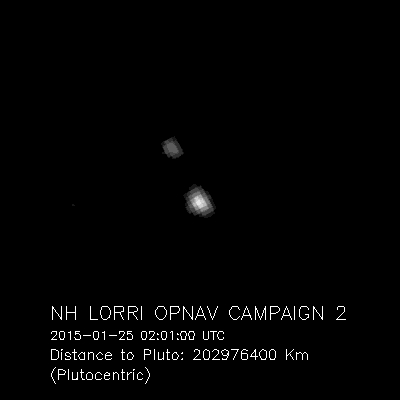
Over the next few months, LORRI will take hundreds of pictures of Pluto against star fields to refine the team's estimates of New Horizons' distance to Pluto. As in these first images, the Pluto system will resemble little more than bright dots in the camera's view until late spring, but mission navigators will use these images to design course-correcting engine maneuvers that precisely aim New Horizons on approach. The first such maneuver based on these "optical navigation" images, or "OpNavs," is scheduled for March 10.
Closing in on Pluto at about 31,000 miles per hour, New Horizons has already covered more than 3 billion miles since launch on Jan. 19, 2006. Its epic journey has taken it past each planet's orbit from Mars to Neptune in record time, and it is now in the first stage of an encounter with Pluto that includes long-distance imaging as well as dust, energetic particle and solar wind measurements to characterize the space environment near Pluto.
"My dad would be thrilled with New Horizons," said Annette Tombaugh, Clyde Tombaugh's daughter, of Las Cruces, New Mexico. "To actually see the planet that he had discovered and find out more about it, to get to see the moons of Pluto ... he would have been astounded. I'm sure it would have meant so much to him if he were still alive today."
APL manages the New Horizons mission for NASA's Science Mission Directorate in Washington. Alan Stern, of the Southwest Research Institute (SwRI), headquartered in San Antonio, is the principal investigator and leads the mission. SwRI leads the science team, payload operations, and encounter science planning. New Horizons is part of the New Frontiers Program managed by NASA's Marshall Space Flight Center in Huntsville, Alabama. APL designed, built and operates the spacecraft.
.
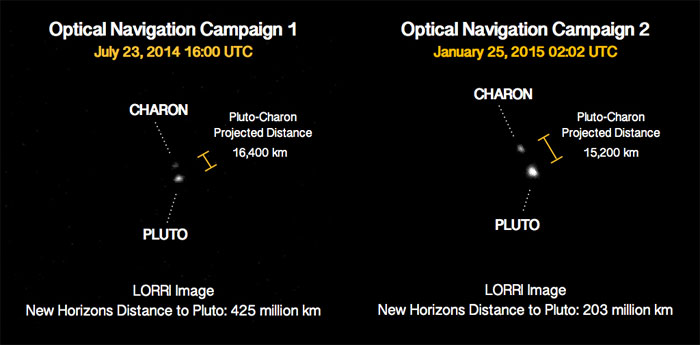
Six Months of Separation: A comparison of images of Pluto and its large moon Charon, taken in July 2014 and January 2015. Between takes, New Horizons had more than halved its distance to Pluto, from about 264 million miles (425 million kilometers) to 126 million miles (203 million kilometers).
Pluto and Charon are four times brighter than and twice as large as in July, and Charon clearly appears more separated from Pluto. These two images are displayed using the same intensity scales. In LORRI's current view, Pluto and Charon subtend just 2 pixels and 1 pixel, respectively, compared to 1 pixel and 0.5 pixels last July. The images were magnified four times to make Pluto and Charon more visible.
Both images were rotated to show the celestial north pole at the top.
Image credit: NASA/Johns Hopkins University Applied Physics Laboratory/Southwest Research Institute.
Quelle: NASA
.
Update: 12.02.2015
.
The View from New Horizons: A Full Day on Pluto-Charon
This time-lapse “movie” of Pluto and its largest moon, Charon, was recently shot at record-setting distances with the Long-Range Reconnaissance Imager (LORRI) on NASA’s New Horizons spacecraft. The movie was made over about a week, from Jan. 25-31, 2015. It was taken as part of the mission’s second optical navigation (“OpNav”) campaign to better refine the locations of Pluto and Charon in preparation for the spacecraft’s close encounter with the small planet and its five moons on July 14, 2015.
Pluto and Charon were observed for an entire rotation of each body; a “day” on Pluto and Charon is 6.4 Earth days. The first of the images was taken when New Horizons was about 3 billion miles from Earth, but just 126 million miles (203 million kilometers) from Pluto—about 30% farther than Earth’s distance from the Sun. The last frame came 6½ days later, with New Horizons more than 5 million miles (8 million kilometers) closer.
The wobble easily visible in Pluto’s motion, as Charon orbits, is due to the gravity of Charon, about one-eighth as massive as Pluto and about the size of Texas.
Faint stars can be seen in background of these images. Each frame had an exposure time of one-tenth of a second, too short to see Pluto’s smaller, much fainter moons. New Horizons is still too far from Pluto and its moons to resolve surface features.
-
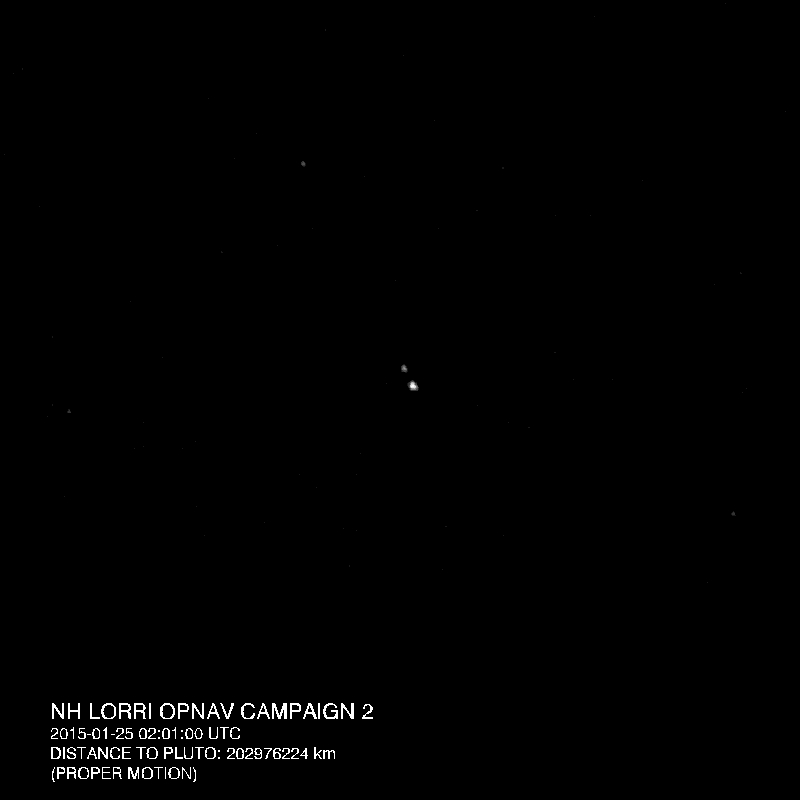
This time-lapse “movie” of Pluto and its largest moon, Charon, was recently shot at record-setting distances with the Long-Range Reconnaissance Imager (LORRI) on NASA’s New Horizons spacecraft.
.
The Pluto-Charon Dance: This close up look at Pluto and Charon, taken as part of the mission’s latest optical navigation (“OpNav”) campaign from Jan. 25-31, 2015, comes from the Long Range Reconnaissance Imager (LORRI) on NASA;s New Horizons spacecraft.
The time-lapse frames in this movie were magnified four times to make it easier to see Pluto and Charon orbit around their barycenter, a mutual point above Pluto’s surface where Pluto and Charon’s gravity cancels out – this is why Pluto appears to “wobble” in space. Charon orbits approximately 11,200 miles (about 18,000 kilometers) above Pluto’s surface.
Each frame had an exposure time of one-tenth of a second, too short to see Pluto’s smaller, much fainter moons.
"These images allow the New Horizons navigators to refine the positions of Pluto and Charon, and they have the additional benefit of allowing the mission scientists to study the variations in brightness of Pluto and Charon as they rotate, providing a preview of what to expect during the close encounter in July," says Alan Stern, the New Horizons principal investigator from the Southwest Research Institute in Boulder, Colorado.
The Johns Hopkins University Applied Physics Laboratory manages the New Horizons mission for NASA's Science Mission Directorate in Washington. Alan Stern, of the Southwest Research Institute (SwRI), headquartered in San Antonio, is the principal investigator and leads the mission. SwRI leads the science team, payload operations, and encounter science planning. New Horizons is part of the New Frontiers Program managed by NASA's Marshall Space Flight Center in Huntsville, Alabama. APL designed, built and operates the spacecraft.
.
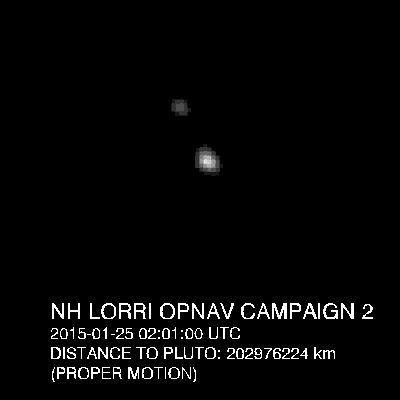
This close up look at Pluto and Charon. Image Credit: NASA/APL/Southwest Research Institute
Quelle: NASA
.
Update: 19.02.2015
.
85 Years after Pluto’s Discovery, NASA’s New Horizons Spots Small Moons Orbiting Pluto
.
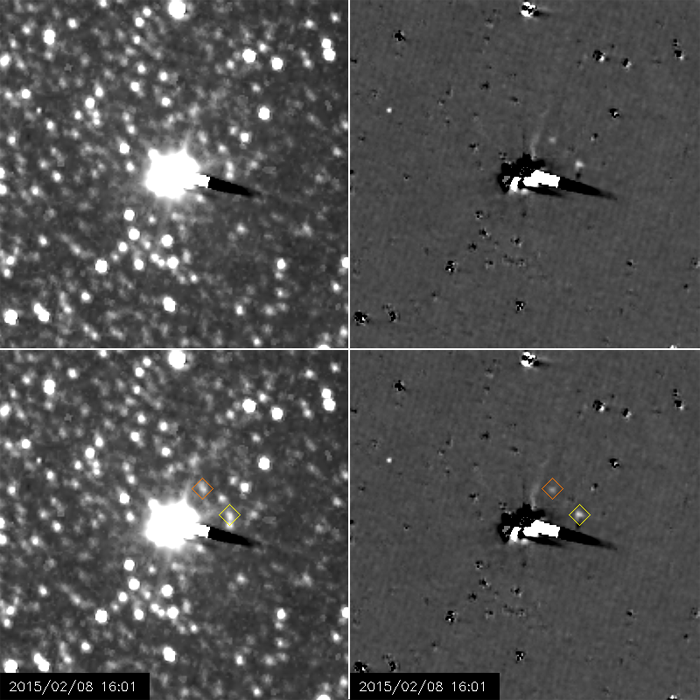
The moons Nix and Hydra are visible in a series of images taken by the New Horizons spacecraft.
Image Credit: NASA/Johns Hopkins APL/Southwest Research Institute
.
Exactly 85 years after Clyde Tombaugh’s historic discovery of Pluto, the NASA spacecraft set to encounter the icy dwarf planet this summer is providing its first views of the small moons orbiting Pluto.
The moons Nix and Hydra are visible in a series of images taken by the New Horizons spacecraft from Jan. 27-Feb. 8, at distances ranging from about 125 million to 115 million miles (201 million to 186 million kilometers). The long-exposure images offer New Horizons’ best view yet of these two small moons circling Pluto which Tombaugh discovered at Lowell Observatory in Flagstaff, Arizona, on Feb. 18, 1930.
“Professor Tombaugh’s discovery of Pluto was far ahead its time, heralding the discovery of the Kuiper Belt and a new class of planet,” says Alan Stern, New Horizons principal investigator from Southwest Research Institute, Boulder, Colorado. “The New Horizons team salutes his historic accomplishment.”
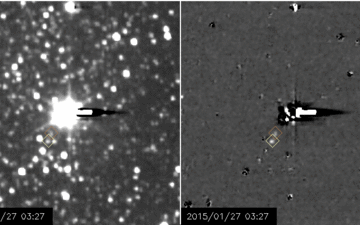
Assembled into a seven-frame movie, the new images provide the spacecraft’s first extended look at Hydra (identified by a yellow diamond ) and its first-ever view of Nix (orange diamond).
Assembled into a seven-frame movie, the new images provide the spacecraft’s first extended look at Hydra (identified by a yellow diamond ) and its first-ever view of Nix (orange diamond). The right-hand image set has been specially processed to make the small moons easier to see. “It’s thrilling to watch the details of the Pluto system emerge as we close the distance to the spacecraft’s July 14 encounter,” says New Horizons science team member John Spencer, also from Southwest Research Institute. “This first good view of Nix and Hydra marks another major milestone, and a perfect way to celebrate the anniversary of Pluto’s discovery.”
These are the first of a series of long-exposure images that will continue through early March, with the purpose of refining the team’s knowledge of the moons’ orbits. Each frame is a combination of five 10-second images, taken with New Horizons’ Long-Range Reconnaissance Imager (LORRI) using a special mode that combines pixels to increase sensitivity at the expense of resolution. At left, Nix and Hydra are just visible against the glare of Pluto and its large moon Charon, and the dense field of background stars. The bright and dark streak extending to the right of Pluto is an artifact of the camera electronics, resulting from the overexposure of Pluto and Charon. As can be seen in the movie, the spacecraft and camera were rotated in some of the images to change the direction of this streak, in order to prevent it from obscuring the two moons.
The right-hand images have been processed to remove most of Pluto and Charon’s glare, and most of the background stars. The processing leaves blotchy and streaky artifacts in the images, and also leaves a few other residual bright spots that are not real features, but makes Nix and Hydra much easier to see. Celestial north is inclined 28 degrees clockwise from the “up” direction in these images.
Nix and Hydra were discovered by New Horizons team members in Hubble Space Telescope images taken in 2005. Hydra, Pluto’s outermost known moon, orbits Pluto every 38 days at a distance of approximately 40,200 miles (64,700 km), while Nix orbits every 25 days at a distance of 30,260 miles (48,700 km). Each moon is probably between 25-95 miles (approximately 40- 150 kilometers) in diameter, but scientists won’t know their sizes more precisely until New Horizons obtains close-up pictures of both of them in July. Pluto’s two other small moons, Styx and Kerberos, are still smaller and too faint to be seen by New Horizons at its current range to Pluto; they will become visible in the months to come.
The Johns Hopkins University Applied Physics Laboratory manages the New Horizons mission for NASA's Science Mission Directorate in Washington. Alan Stern, of the Southwest Research Institute (SwRI), headquartered in San Antonio, is the principal investigator and leads the mission. SwRI leads the science team, payload operations, and encounter science planning. New Horizons is part of the New Frontiers Program managed by NASA's Marshall Space Flight Center in Huntsville, Alabama. APL designed, built and operates the spacecraft.
Quelle: NASA
.
Update: 26.02.2015
.
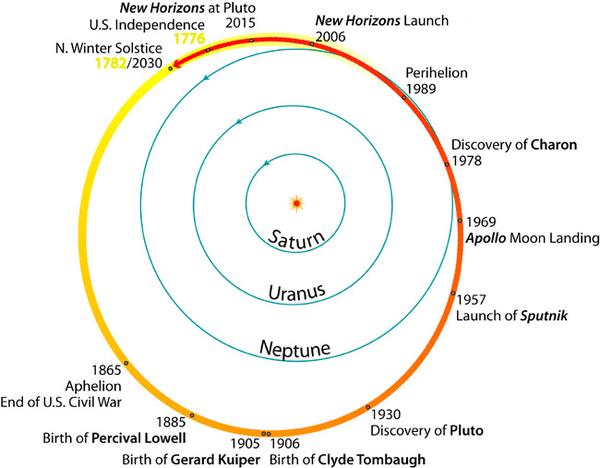
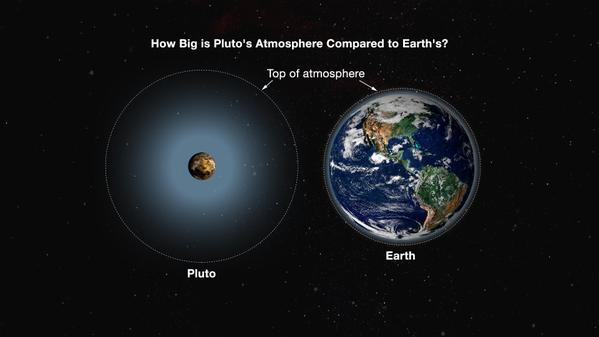
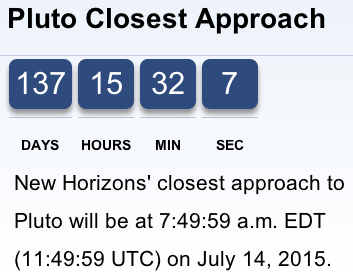
Quelle: NASA
-
Update: 14.03.2015
.
A Record Day for New Horizons

Next exit: Pluto!
After more than nine years in space, on a voyage taking it farther to its primary destination than any mission before it, NASA'’s New Horizons spacecraft is within one astronomical unit of Pluto – meaning it’s closer to Pluto than the Earth is to the Sun.
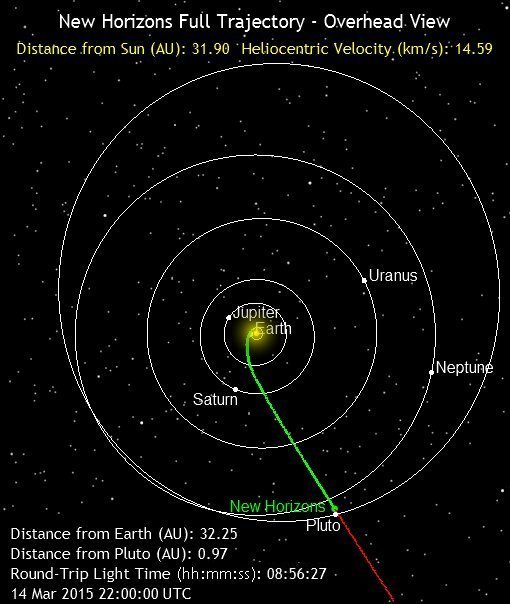
Speeding along at nearly 33,000 miles per hour, New Horizons sailed past its last symbolic deep space mile marker at about 5:20 p.m. EDT on March 10. An astronomical unit (AU) is the average distance between the Earth and Sun, about 93 million miles or 149 million kilometers. All told, New Horizons' epic journey from Earth to Pluto has covered almost 32 AU — about 3 billion miles.
"This is an amazing project — one that will go down in the history 21st century achievements," said New Horizons Principal Investigator Alan Stern, of Southwest Research Institute, Boulder, Colorado. "And the history-making is just beginning — in July we reach Pluto, humankind’s farthest exploration shore, to explore it and its fascinating system of moons for the first time!"
A Record Engine Burn
The New Horizons mission set another historic marker on March 10, performing the record-distance trajectory correction burn in the history of spaceflight. New Horizons was 2.96 billion miles (4.77 billion kilometers) from the Sun at the time of the maneuver; Voyager 2, the previous record-holder, was approximately 2.8 billion miles (4.5 billion kilometers) for its last engine burn near Neptune in August 1989.
.

-
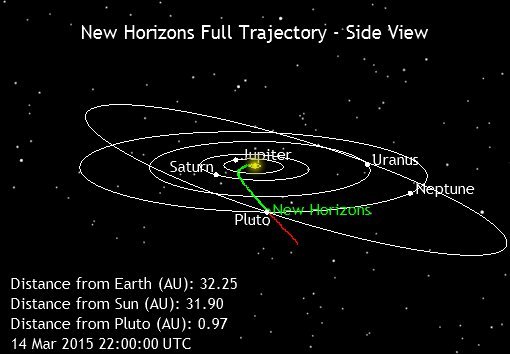
Quelle: NASA
.
Update: 9.04.2015
.
Colorado camera to take first close-up photos of Pluto
.
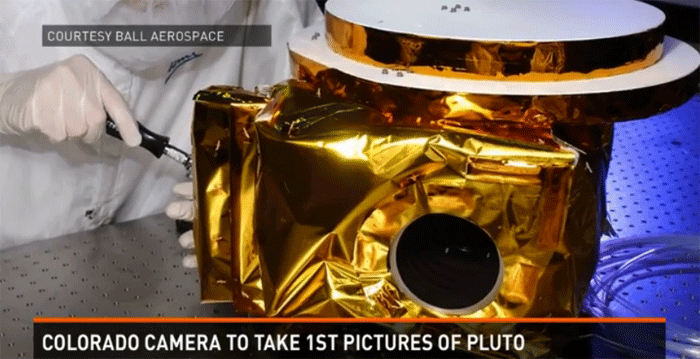
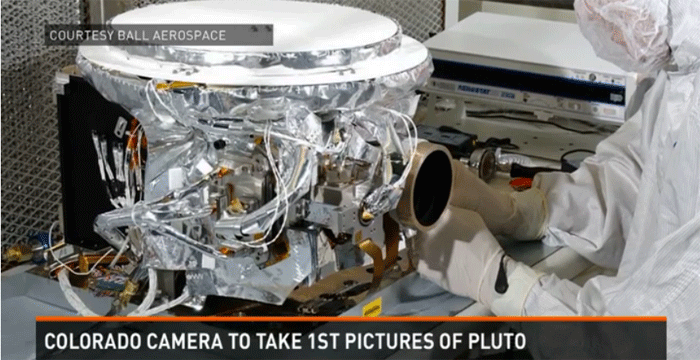
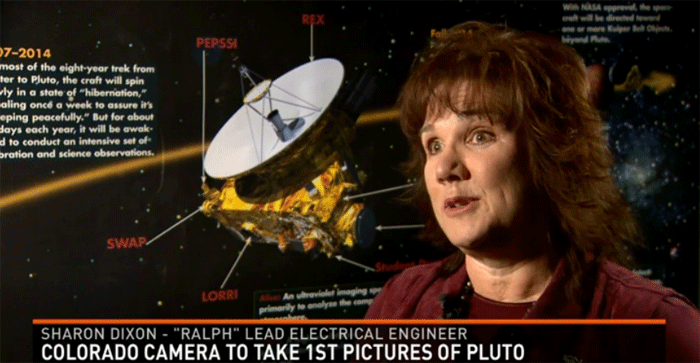
Boulder-based Ball Aerospace built the instrument "Ralph," which is onboard New Horizons and fast approaching Pluto.
.
BOULDER - Imagine trying to take a picture in the cold of outer space while traveling at a speed of more than 31,000 miles an hour.
It's a scenario that Lisa Hardaway, at Ball Aerospace in Boulder, has dealt with for more than a decade.
"For us, it's very tense," she said. "We didn't build something that we've already built before. This is a unique instrument."
The instrument is "Ralph," a camera onboard the New Horizons spacecraft. For the past nine years, NASA's New Horizons has been making its way to Pluto -- the first spacecraft to ever do so. Ralph will take the first clear pictures ever of the dwarf planet.
"It's much more complex than say, a point-and-shoot that you might have in your pocket," Hardaway said.
So far, the best pictures photographed of Pluto are blurry shots taken by the Hubble Space Telescope. The hope is Ralph will literally open up a whole new world for us to see.
"We're going to be writing new chapters about Pluto in all the books that the next generation reads," said Sharon Dixon, "Ralph's" Lead Electrical Engineer.
It took several years for Ball Aerospace to develop the $20 million "Ralph" – repeatedly testing it -- to make sure it would be able to handle the more than three-billion mile voyage to Pluto.
"There is no room for error, so we simulated being out there in space, where you're super cooling it," Dixon said. "You're shaking it, making sure nothing breaks so that it survives the launch."
Accompanying "Ralph" on the voyage to Pluto is a companion Ultraviolet instrument, built by Southwest Research Institute, called "Alice."
Yes — that's Ralph and Alice.
"It is a nod to the Honeymooners," Hardaway said. "Our principal investigator has a great sense of humor."
It's dynamic duo that will now give all of us a good look at place that seemed out of reach for so long.
New Horizons will have its close encounter with Pluto this July. Ralph will begin capturing images of the planet during the next several months.
Quelle: 9NEWS
-
Update: 14.04.2015
.
NASA’s New Horizons Spacecraft Nears Historic July 14 Encounter with Pluto
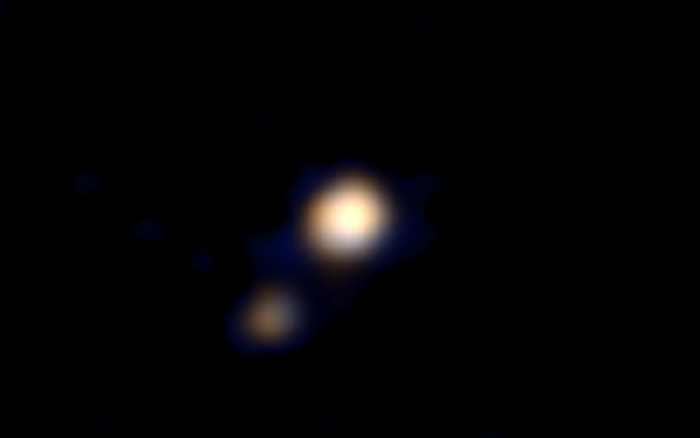
First Color Image / NASA
.
NASA’s New Horizons spacecraft is three months from returning to humanity the first-ever close up images and scientific observations of distant Pluto and its system of large and small moons.
"Scientific literature is filled with papers on the characteristics of Pluto and its moons from ground based and Earth orbiting space observations, but we’ve never studied Pluto up close and personal,” said John Grunsfeld, astronaut, and associate administrator of the NASA Science Mission Directorate at the agency’s Headquarters in Washington. “In an unprecedented flyby this July, our knowledge of what the Pluto systems is really like will expand exponentially and I have no doubt there will be exciting discoveries."
The fastest spacecraft ever launched, New Horizons has traveled a longer time and farther away – more than nine years and three billion miles – than any space mission in history to reach its primary target. Its flyby of Pluto and its system of at least five moons on July 14 will complete the initial reconnaissance of the classical solar system. This mission also opens the door to an entirely new “third” zone of mysterious small planets and planetary building blocks in the Kuiper Belt, a large area with numerous objects beyond Neptune’s orbit.
The flyby caps a five-decade-long era of reconnaissance that began with Venus and Mars in the early 1960s, and continued through first looks at Mercury, Jupiter and Saturn in the 1970s and Uranus and Neptune in the 1980s.
Reaching this third zone of our solar system – beyond the inner, rocky planets and outer gas giants – has been a space science priority for years. In the early 2000s the National Academy of Sciences ranked the exploration of the Kuiper Belt – and particularly Pluto and its largest moon, Charon – as its top priority planetary mission for the coming decade.
New Horizons – a compact, lightweight, powerfully equipped probe packing the most advanced suite of cameras and spectrometers ever sent on a first reconnaissance mission – is NASA’s answer to that call.
“This is pure exploration; we’re going to turn points of light into a planet and a system of moons before your eyes!” said Alan Stern, New Horizons principal investigator from Southwest Research Institute (SwRI) in Boulder, Colorado. “New Horizons is flying to Pluto – the biggest, brightest and most complex of the dwarf planets in the Kuiper Belt. This 21st century encounter is going to be an exploration bonanza unparalleled in anticipation since the storied missions of Voyager in the 1980s.”
Pluto, the largest known body in the Kuiper Belt, offers a nitrogen atmosphere, complex seasons, distinct surface markings, an ice-rock interior that may harbor an ocean, and at least five moons. Among these moons, the largest – Charon - may itself sport an atmosphere or an interior ocean, and possibly even evidence of recent surface activity.
“There’s no doubt, Charon is a rising star in terms of scientific interest, and we can’t wait to reveal it in detail in July,” said Leslie Young, deputy project scientist at SwRI.
Pluto’s smaller moons also are likely to present scientific opportunities. When New Horizons was started in 2001, it was a mission to just Pluto and Charon, before the four smaller moons were discovered.
The spacecraft’s suite of seven science instruments – which includes cameras, spectrometers, and plasma and dust detectors – will map the geology of Pluto and Charon and map their surface compositions and temperatures; examine Pluto’s atmosphere, and search for an atmosphere around Charon; study Pluto’s smaller satellites; and look for rings and additional satellites around Pluto.
Currently, even with New Horizons closer to Pluto than the Earth is to the Sun, the Pluto system resembles little more than bright dots in the distance. But teams operating the spacecraft are using these views to refine their knowledge of Pluto’s location, and skillfully navigate New Horizons toward a precise target point 7,750 miles (12,500 kilometers) from Pluto’s surface. That targeting is critical, since the computer commands that will orient the spacecraft and point its science instruments are based on knowing the exact time and location that New Horizons passes Pluto.
“Our team has worked hard to get to this point, and we know we have just one shot to make this work,” said Alice Bowman, New Horizons mission operations manager at the Johns Hopkins University Applied Physics Laboratory (APL) in Laurel, Maryland, which built and operates the spacecraft. “We’ve plotted out each step of the Pluto encounter, practiced it over and over, and we’re excited the ‘real deal’ is finally here.”
The spacecraft’s work doesn’t end with the July flyby. Because it gets one shot at its target, New Horizons is designed to gather as much data as it can, as quickly as it can, taking about 100 times as much data on close approach as it can send home before flying away. And although the spacecraft will send select, high-priority datasets home in the days just before and after close approach, the mission will continue returning the data stored in onboard memory for a full 16 months.
“New Horizons is one of the great explorations of our time,” said New Horizons Project Scientist Hal Weaver at APL. “There’s so much we don’t know, not just about Pluto, but other worlds like it. We’re not rewriting textbooks with this historic mission – we’ll be writing them from scratch.”
APL manages the New Horizons mission for NASA’s Science Mission Directorate in Washington. Alan Stern of SwRI is the principal investigator. SwRI leads the science team, payload operations and encounter science planning. New Horizons is part of the New Frontiers Program, managed by NASA's Marshall Space Flight Center in Huntsville, Alabama.
Quelle: NASA
.
Update: 29.04.2015
-
NASA to Hold Media Call on Latest Images of Pluto from New Horizons Spacecraft
NASA will host a media teleconference at 3:30 p.m. EDT on Wednesday, April 29 to discuss recent images returned from the New Horizons spacecraft as it nears its historic July 14 encounter with Pluto. Officials also will provide an update on the timeline and significance of images the mission team will receive in the coming weeks.
Participants will be:
John Grunsfeld, associate administrator for the Science Mission Directorate, NASA Headquarters, Washington
Alan Stern, New Horizons principal investigator, Southwest Research Institute, Boulder, Colorado
Hal Weaver, New Horizons project scientist, Long Range Reconnaissance Imager telescopic camera instrument team, Johns Hopkins Applied Physics Laboratory in Laurel, Maryland
Quelle: NASA
5178 Views
